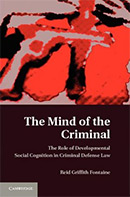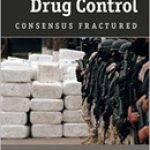The Mind of the Criminal: The Role of Developmental Social Cognition in Criminal Defense Law

Author: Reid Griffith Fontaine
Publisher: New York: Cambridge University Press, 2012. 264p.
Reviewer: Mark R. Fondacaro | November 2012
In his book, “The Mind of the Criminal,” Reid Griffith Fontaine, a researcher and scholar superbly trained in both psychology and law, attempts to integrate aspects of developmental social cognitive research and criminal defense law. At the broadest level, Fontaine provides a preliminary sketch of an overarching “Social Cognitive Jurisprudence” grounded in retribution as the primary justification for punishment. At a more micro level, he provides an analytic defense of the criminal law’s retributive roots and the traditional legal presumptions about human agency in which those roots are planted. But it is at the more intermediate level of legal doctrine, at the intersection of psychological science and the law of excusing defenses, where Fontaine finds his sweet spot and makes his most important contributions. In this book review, I will provide a brief summary and critical analysis of his overall framework and highlight some of the strengths and limitations of his particular proposals for legal and policy reform.
In each of the specific areas of criminal defense law he addresses, Fontaine brings together the highest level of social cognitive developmental research and cutting edge scholarly analysis of existing legal doctrine. His interdisciplinary synthesis is masterful in each of the specific areas of affirmative defense law he tackles, and his recommendations for legal and policy reform provide much needed data-driven challenges to the legal status quo. Overall, his work more than lives up to the promise of the title to illuminate “The Role of Developmental Social Cognition in Criminal Defense Law.” However, it is when he ventures outside the bounds of specific affirmative defenses to broader issues of jurisprudence and justifications for punishment that his work falls short of making full use of behavioral science research in informing jurisprudence and constructive legal reform. I will return to these broader and more foundational issues after highlighting some of the consistent substantive themes of his work.
Based on his integration of legal scholarship and behavioral science research, Fontaine considers “subrationality” as the basis for mitigating or totally excusing criminal defendants from legal responsibility in a wide range of legally relevant contexts, including cases involving juvenile crime, provocation and heat-of-passion homicide, mistaken self-defense, and duress. He also calls for mitigation for adults whose moral-cognitive capacity is “underdeveloped” and examines the effects of chronic abuse and trauma on social cognitive development and the relevance to reactive homicides. In each of these areas where behavioral science and law intersect, Fontaine pushes the boundaries of traditional doctrine toward empirically informed legal reform. For example, in the juvenile realm, Fontaine makes the distinction between underdevelopment of rationality, where the “rational capacity” that the law presumes for adults has never been attained, and diminished rationality, where the rational capacity that the law presumes for adults has been attained at some point but has since become compromised for some reason. He covers some new ground here by arguing that “underdeveloped rationality” is not necessarily limited to juveniles, and if those over eighteen indeed have an underdeveloped rational capacity, their level of culpability and degree of punishment should be mitigated or negated accordingly. All too often in the area of juvenile justice, efforts are made to identify distinctions between juveniles and adults that justify treating juveniles differently. Absent from the usual discourse is principled, critical analysis to deal with adults whose psychological capacities may be indistinguishable from children and young adolescents. Fontaine clearly takes this bold step forward with his work.
Likewise, he points to subrationality in the moral realm and suggests that “[it] may be that nonculpable underformation or malformation of moral rationality should serve as a mitigating (excusing) condition in the case of the morally uncomprehending individual.” [p.148] With respect to heat of passion, mistaken self-defense, duress, and even cases where the defendant has experienced abuse and trauma, he argues that subrationality should expand the scope of these defenses and provide mitigation and/or excuse to defendants who typically would be held fully accountable under traditional criminal law doctrine. In this sense, Fontaine has proposed a framework for a retributive jurisprudence of affirmative defenses that is less punitive than the legal status quo. This is clearly a scholarly accomplishment that true philosophical retributivists should be drawn to, especially if the empirical evidence indeed shows that these classes of defendants truly have a “rational capacity” that is materially compromised in comparison to the actual “rational capacity” of the typical adult. However, this is where Fontaine’s grounding in retributive justifications for punishment raises some difficult questions.
For example, if adult defendants may have underdeveloped rationality that is comparable to the rational capacity of an adolescent, or if defendants in homicide cases can have provocation interpretational biases that mitigate their culpability, or have threat interpretational biases, or moral subrationality that totally excuses their behavior on retributive grounds, what are we to do with these potentially dangerous individuals (perhaps murderers under current criminal law doctrine who do not satisfy mental illness criteria for either an insanity defense or civil commitment))? Since they are not criminally responsible, do we release them to the public, violence-inducing social cognitive biases and all? I suspect this is where the non-philosophical, pragmatic retributivists who are more explicitly comfortable with notions of revenge might begin to have some second thoughts about going down this path. Fontaine seems to anticipate this concern and attempts to address it by limiting the expansion of excusing defenses to those cases where the subrationality was non-culpably developed. However, this strategy has only a limited effect on narrowing the scope of excusing defenses because childhood abuse and trauma are repeatedly referred to throughout the book as the kinds of developmental experiences that lead to non-culpably formed subrationality. Given the traumatic life histories of a significant percentage of the offenders now incarcerated in our criminal justice system, it seems that under Fontaine’s proposed reforms, many if not most criminal defendants would attempt to claim mitigation or excuse based on non-culpably formed subrationality.
However, the problems associated with grounding this new interdisciplinary jurisprudence almost exclusively in retributive justifications for punishment (with the exception of juvenile offenses) are more fundamental and run deeper than the issue of expanding the scope of excusing defenses available to potentially dangerous individuals. The more fundamental issue is that while Fontaine argues that rigorous behavioral science research should be used to take on and address empirical issues in the law, he fails to call on existing or future research to take on fundamental legal presumptions about human behavior that are clearly amendable to empirical analysis. Throughout the book, he argues that the law presumes that people are rational actors who have the “rational capacity” and do in fact act for reasons. Most retributivists concede that a retributive system stands or falls on the validity of this presumption. However, some of the most ambitious efforts to determine whether there is in fact a direct empirical link between cognition and behavior of the kind reflected in folk psychology, common sense, and the law have led to an emerging scientific consensus that “conscious processes lack causal efficacy” [see Baumeister et al. 2011]. At the very least, this legal presumption at the foundation of a retributive system of criminal justice clearly warrants the kind of scientific scrutiny and analysis that Fontaine recommends in other domains outside the scope of these foundational assumptions.
In discussing the relationship between behavioral science and the law, Fontaine distinguishes between the goals of psychology, which he states are to “discern, understand, predict, and explain individual differences in behavior,” [p.1] and the law, which he describes as to “negatively prescribe behavior, judge the wrongfulness and harmfulness of specified forms of conduct, and determine what, if anything, should be the response on the part of the government when it has been determined that criminal wrongdoing has occurred.” [p.2] He makes a primary distinction between psychology’s emphasis on empirical issues and the law’s concern with normative ones, such as how to redress the moral imbalance created by wrongful conduct. It is this traditional framing of the disciplines, one that may be characterized by more progressive scholars as one-sided and incomplete, that defines (and limits) the scope of the potential contribution of this very ambitious work of interdisciplinary scholarship. For example, given Fontaine’s training and explicit focus on developmental social cognitive research, it is no surprise that he sees the primary goals of psychology as the description, explanation and prediction of human behavior. However, here, he excludes the central role that behavior “change” plays in applied areas of social, clinical and community psychology–a goal that does or should dovetail with the law’s concern with “prescribing behavior” and “responding” to criminal conduct. The failure to adequately acknowledge and address the role of psychological science in understanding and facilitating behavior change seemingly contributed to the absence of any significant discussion in chapter 4 of the burgeoning body of research on highly effective interventions with juvenile offenders—interventions that focus not only on changing decision making, but the peer, family, and community factors that influence delinquent behavior.
As noted above, Fontaine does not include the “judgment” of human behavior on the list of central aims of behavioral science and categorizes it instead within the realm of the law. However, this categorization fails to take into consideration the extensive body of behavioral science research on the social judgment process. In dealing with issue of mens rea and culpability, Fontaine treats these constructs as though they were almost entirely characteristics of the individual offender. However, determining what a particular defendant was thinking at the time he or she committed an illegal act is based on a retrospective social judgment made typically by jurors whose judgments may indicate as much or more about their own social information processing and biases as they do about the defendant’s. In any case, this is a social judgment process that is entirely amenable to empirical analysis. There is much of legal relevance that can be learned from behavioral science research demonstrating whether people, including jurors, have a general tendency to read intentionality into behavior even when it is not possible, or research examining whether defendant characteristics (e.g., age, race, gender, sexual orientation, social status) can systematically bias jurors’ judgments of mens rea. These seem to be psycholegal issues of “judgment” that are clearly within the realm of behavioral science research. Moreover, they are the kind of issues that place judgments about the internal workings of the “mind” of the criminal in a clarifying social context. Overall, this excluded body of psychological literature on the social judgment process seems to have important implications for determining whether legal judgments about a defendant’s past mental state are or ever can be accurate and valid, a presumption at the heart of retribution and the foundation of Fontaine’s analysis.
In sum, “The Mind of the Criminal” provides a comprehensive and thorough review of the relevant legal and behavioral science literatures. This alone makes it a valuable read for criminal defense attorneys wanting to polish up on the law and the latest relevant behavioral science research. This ambitious work of interdisciplinary scholarship is also a must read for psycholegal researchers in search of new and important areas of the law in need of empirical investigation. Perhaps of most significance, this book provides a potential road map for blazing new trails toward mitigation for criminal defendants. However, one of the major limitations of this work is the failure to take full advantage of the potential contributions that cutting edge behavioral science research can, should, and probably will make to legal reform, at least in the distant future.
Acknowledgement: As noted in the Preface of this book, I had the opportunity to review and provide critical comments and feedback to the author on an unpublished draft of this book. The book review that follows is based on my subsequent, independent review of the final published version of the book.
References
Roy F. Baumeister et al., Do Conscious Thoughts Cause Behavior? 62 Ann. Rev. Psychol. 331, 353(2011).
Mark Fondacaro is a Visiting Professor at the Duke University Center for Child and Family Policy and a Professor of Psychology at John Jay College of Criminal Justice, City University of New York.


